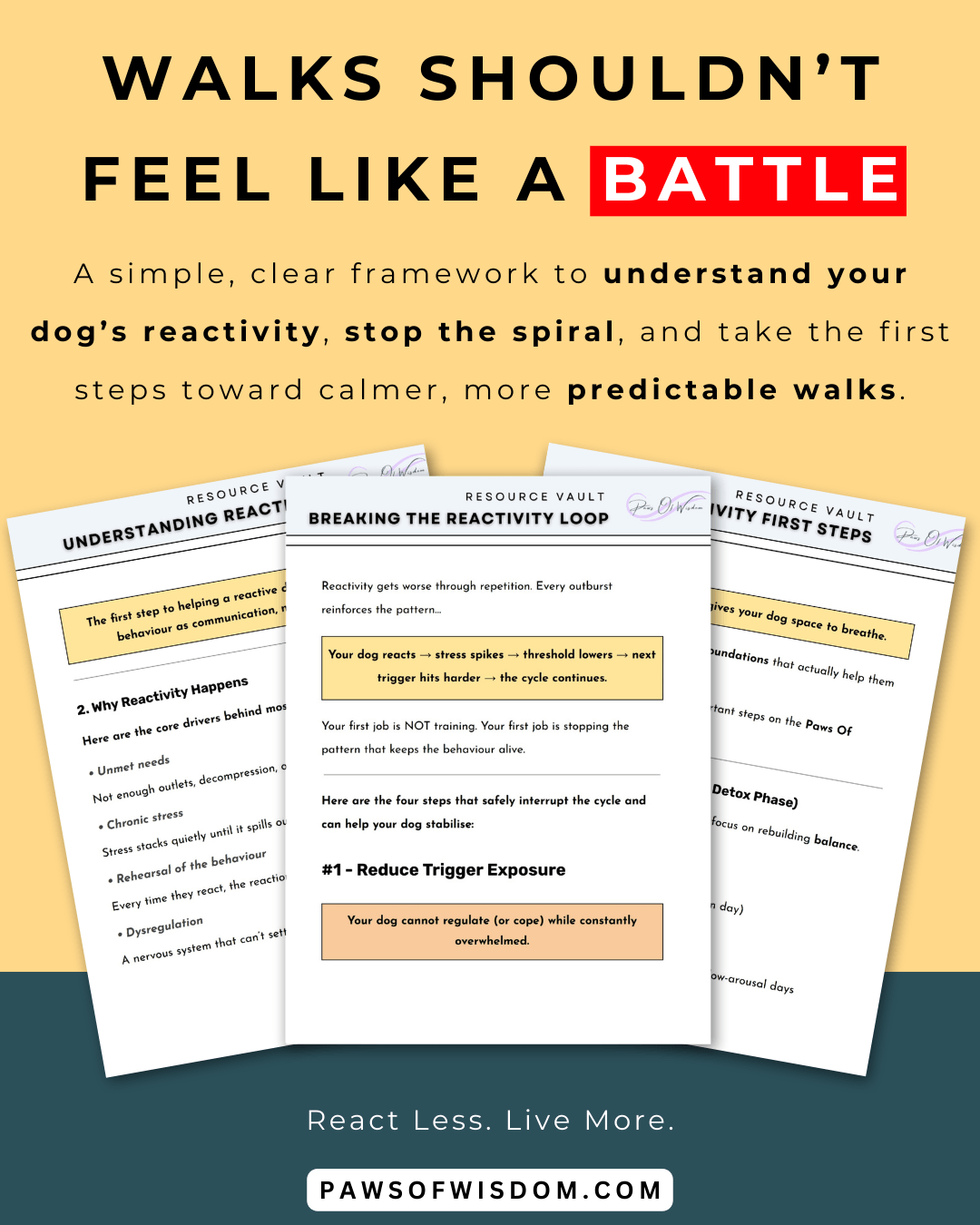How to Walk a Reactive Dog (Even If It Feels Impossible Right Now)
Learning how to walk a reactive dog takes more than teaching them proper leash manners. It’s about understanding what’s really going on beneath the surface — their stress, their triggers, their threshold distance — and learning how to support them (and yourself) with the right guidance and structure.
The pressure to avoid other dogs, constantly planning your route, the tension when they spot something before you do, the sting of another meltdown in public…it all adds up. Even simple walks can start to take their toll and feel more like annoying side quests — draining, emotional, and far from enjoyable.
In this post, I’ll walk you through why these walks can feel so difficult, what can make a difference (and what really doesn’t), and how you can start taking more confident steps forward — even if you and your dog aren't perfect yet.

Why Walks Feel So Overwhelming (Even Before You Step Outside)
If you’ve got a reactive dog, walking them can feel like walking you're literally walking a ticking time bomb. One unexpected trigger out of nowhere and your calm, well laid plans can unravel in seconds. And when that happens — again — it’s not just frustrating. It’s heartbreaking.
What makes it worse is the outside judgement and pressure, the stranger who tells you to “just train your dog,” or the other owners letting their dogs charge over “because they’re friendly,” you’re constantly having to advocate for your dog while managing your own emotions. It can be a lot for anyone to juggle with.
It took me a longer than I would have liked to learn that walking a reactive dog isn’t just about training: it’s about learning how to move through the world together as a team, with less stress, more understanding, and small, steady wins that build your confidence back up, one walk at a time.
Understanding Reactivity: It’s Not Just Bad Behaviour
I think it's become a bit more of a common understanding that leash reactivity, even though it is an unwanted reaction, it’s not a "bad behaviour". It’s about a nervous system that’s overwhelmed.
When a dog reacts they aren't being aggressive, they're giving information...they're telling you “I can’t cope with this right now.”
Sometimes it’s fear. Sometimes it’s frustration. Sometimes is anxiety. Sometimes it’s just because it's Sunday. And when a dog has no way to release or regulate all that internal pressure, it spills out in the most chaotic ways, at the worst of times.
Reactivity isn’t just one moment — it’s a build up of triggers and stressors over the day — it’s the outcome of stress, poor rest, lack of outlets, overwhelming environments, and a dog who hasn’t been shown another way yet. That’s why you can do all the right training and still feel like you’re hitting a wall.
Understanding that reactivity is a symptom, not the root issue, helps you take a step back and start asking better questions:
What’s been building up today?
What’s their sleep been like?
Have I provided them with an outlet for any frustration
Do they need this walk? Or would they benefit from enrichment/decompression?
Are we walking in an environment that actually helps them succeed?
Preparing for the Walk: Setting Your Dog Up for Success
Over time I learned that walking a dog doesn’t start when you step outside, it starts long before that — with how you prepare your dog — do you hype them up before they go? Do you let them charge out the door? If so there's a chance that's exactly how the rest of your walk will continue; all stress, arousal and no good choices.
So before you even touch the lead, ask yourself: What state is my dog in right now? Have they had enough rest? Are they overstimulated from earlier? Did they just bark at the postman? Are tthey feeling rushed or frustrated? Do they really need this walk or would they benefit from an outlet work with a decompression session to finish?
Below are 5 tips you can use today to start your walks off on the right paw...
#1 - Keep your dog under threshold
Your dogs threshold is the invisible bubble between “my dog can cope” and “my dog is about to explode.”
Learn to spot the early signs of discomfort (ears up, lip licking, tension, disengagement, freezing) and create space before things escalate. Remember your dog can't learn when they are reacting so space is your friend!
#2 - Distance is your superpower
The further your dog is from a trigger, the more likely they are to stay calm and under threshold. Your main goal should be to keep your dog under threshold as much as you can. It may seem silly but if that means you have to cross the road, do a U-turn, or hide behind a parked car, then do it. There’s no shame in it — you’re teaching predictability and trust for now, not avoidance.
#3 - Be aware of your voice and body language
One thing I commonly see with reactive dogs, and something I was guilty of, is letting your emotions get involved in the situation. We see a dog and we instantly send signals of panic to our dog. Or maybe our dog reacts and we flail around fogetting everything we've learned in frustration.
This is so much easier said than done but stay calm, light, and upbeat (even if you’re dying inside). Use a firm but calm tone. Keep a relaxed posture (don't forget to breathe). Use your body to block and direct your dog. Don't overcomplicate the situation, only use cues your dog knows and only when you feel they'll follow through.
Your dog needs calm guidance in these situations, how can you expect them to follow suit if you can't control yourself.
#4 - Be more engaging
You don't have to be more exciting than a squirrel or another dog. You just have to prove to your dog that you can be a source of fun and engagment.
A lot of owners miss out on a massive opportunity with engagement when dogs check in and look at them on a walk. Usually, the owner is checked out as well...and then we ask our dogs to engage when it's convenient for us.
Reinforce your dog for checking in. Do little obedience and engagement drills. Randomly bust out a tug toy.
If you can show your dog that there is opportunity to engage with you outside instead of just satisfy their needs alone, you will find it so much easier to get their engagement in harder situations.
#5 - Know when to bail
Sometimes when things aren't going the way that you planned, you may have to make the executive decision to go home early. If your dog is already overstimulated and reaching a breaking point, continuing the walk can make things worse. End on a small win such as a scatter feed session in a quiet area, or a frozen kong and some place work, and reset for tomorrow.
After the Walk: Reflect and Adjust
What happens after the walk matters just as much as what happens during it, for both you and your dog. If your walk went well, celebrate it. If it didn’t? That doesn’t mean you failed — it just means there’s something to learn.
These small 3 things really helped me start building momentum to better walks with my reactive dog...
#1 - Take a moment to decompress
Decompression is so important after walks. Dogs that have stress fueled walks usually end up coming back home tense and stressed out.
I usually opt for giving some calming activity or enrichment such as a chew of some sort, snuffle mat, a gentle massage, frozen kong or even a bit of scent work or something (or sometimes a combination of them).
And for yourself? Breathe. Unclench your jaw. Release that tension.
#2 - Journal & reflect on what worked
Journaling became such a cornerstone to both mine and Jasper's growth.
After walks and training sessions I'd just write how it went. Did he respond well to extra space? Did we handle an unexpected trigger with more confidence than last week? How long did he settle down for?
Then I'd write what went well, and what not so well, and what I'd do differently in that situation. This really helped me think and visualise situations and what success looked like, and also for spotting patterns of things I kept doing.
All of this was a game changer for me. Not just to track patterns, but to understand what triggered them: time of day, environment, sleep quality, mood. I started noticing things I would’ve missed otherwise.
If you're not already tracking your walks, I can’t recommend it enough.
My Notion Dog Training Journal was built for this — it helps you see the bigger picture, track wins, spot stress stacking, and keep your sanity in the process.
#3 - Adjust your plan
When you reflect on the plan, you can adjust the plan.
Before I got into journaling my progress, the only reflection I'd do was a slight rant. Sometimes it would ruin my mood for the whole day and you know what....I'd make the same mistake a few days later.
If you can reflect on what went wrong from your walk, and adjust things according to that you can make a lot more progress than just rolling with the punches and hoping for the best.
You might start to think "maybe that route is too much for now", or "maybe mornings are better than evenings", or even "maybe we should skip the walk and focus on a decompression day tomorrow". These simple course corrections can help make sure you are on the right path.
The more you reflect, the more intentional your training starts to become.
10 Quick Wins You Can Try Today
Switch up your walking time
Discover the best time to walk your dog. Walk early mornings or late evenings when the world’s quieter. Fewer triggers = more breathing room.
Choose your routes wisely
Avoid busy streets. Quiet paths, car parks, or industrial estates can be your best friend.
Keep sessions short
You don’t need long walks — 20 calm minutes with outlets and enrichment through the day is more powerful than an hour of chaos.
Use the environment
Parked cars, hedges, bins — anything that helps create a visual barrier from triggers even if it looks silly.
Train/Play before the walk
A few minutes of play, sniffing, or obedience can help take the edge off before heading out.
Bring high value rewards
Use treats your dog loves — and don't be shy about feeding often for calm behaviour. Pay your dog, build that reinforcement history!
Learn to read body language
Learn body language including signals when they are starting to feel uncomfortable or before reacting. Understanding these warning signs can help you keep your dog under threshold.
Pre-walk decompression helps
Try a sniffari, scatter feed, or enrichment box before heading out to lower arousal.
Be your dog’s advocate
Don’t be afraid to say no to people who want to interact. Your dog’s wellbeing comes first.
Track the patterns
What helped today? What didn’t? Noting these down helps you spot what your dog actually needs.
Want to Get a Handle on the Bigger Picture?
Understanding your dog’s reactivity isn’t just about managing walks — it’s about learning how all the pieces fit together like a puzzle.
The Reactivity Starter Bundle is your next step if you’re feeling lost, overwhelmed, or just ready for more structure.
Inside, you’ll find free resources to help you:
Understand why your dog reacts the way they do
Learn how stress, arousal, and environment all connect
Get practical tools to start making calmer, more confident choices
Whether you're just starting or need a reset, this bundle was made for dog owners like you — because your dog deserves a plan that actually works.
Final Thoughts
Walking a reactive dog isn’t just a training challenge — it’s a daily load that most people won’t understand unless they’ve lived it.
You don’t have to do it all at once. You don’t have to get it perfect. But if you can bring more calm into your dog’s day — and your own — one small step at a time, that’s progress, and progress builds up.
So if today wasn’t perfect, that’s okay. Try again tomorrow.
Frequently Asked Questions (FAQs): Reactive Dog Walking
Start by giving your dog the space they need to feel safe. That might mean crossing the road or turning around and increasing distance before they hit their threshold. Pair distance with calm cues, scatter feeding, and engagement games. Calm isn’t trained in the moment — it’s built through consistent routines, decompression, and stress management outside the walk too.
If your dog is locked on, they’re probably already over threshold. Step back, use your voice gently, toss treats behind them, and give them time. All of this however, is built with your foundations in low stress environments first.
Not always. Sometimes, taking a break from walks is the best thing you can do — especially if every walk leaves your dog more stressed out. By skipping a walk, you’re prioritising decompression, rest, and controlled outlets until they’re more regulated. That’s exactly what my 5-Day Stress Detox is designed for.
If there’s any risk of your dog biting, then yes — muzzling is responsible and respectful to everyone involved. It means you’re protecting your dog, others, and creating safety while you work on the underlying behaviour. Plus, the confidence you have with a dog on a muzzle can help you make more progress that without!
Quiet, open spaces where you can see triggers from a distance are ideal. Think less busy parks, industrial estates and car parks during quiet hours, quiet fields, or even a short walk around the block during off-peak times. The goal isn’t mileage — it’s regulation.
Related Reading
A FREE community with downloadable guides and resources, and people who get it.
A simple and structured reset for overstimulated, dysregulated, chaotic dogs.
Simple, clear guidance to help you understand your dog through a regulation-first lens.
















